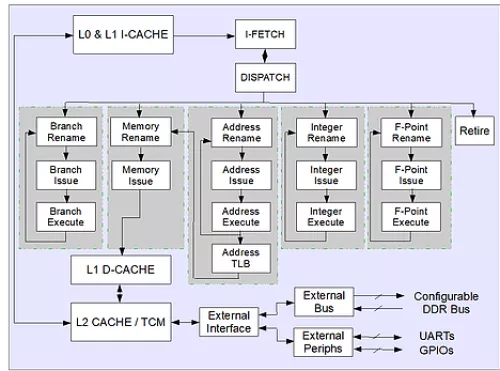At the heart of the Unity platform is the ‘Unity’ CPU core. The CPU is validated in TSMC’s 28nm process and is configurable for multiple performance levels.
CPU - Unrivalled scalability for heterogeneous design
Overview
Key Features
- Operating frequency:
- Up to 2.5 GHz, based on process technology and optimization selection
- Out-of-order pipeline:
- Increased instruction throughput; 256 in-flight instruction capable
- Distributed instruction decoding:
- Optimizes design for power and performance through localized instruction decoding
- Distributed register files:
- Reduces register rename complexity and register file ports
- General Purpose, F-Point, Address, and Branch Jump Target register files
- Distributed register renaming:
- Localized to each functional unit for register files owned by the functional unit to achieve higher instruction throughput and simplify register rename logic
- Capable of up to 63 physical registers per unit
- Instruction prefetch structure:
- Reduces instruction dispatch time
- Branch Predictor:
- Reduces memory access times / improves execution performance
- 2048 2-bit saturating branch predictor
- L0 and L1 I-caches:
- Facilitate fast instruction fetch; configurable to user requirements
- L1 D-cache:
- Enables fast memory accesses; configurable to user requirements
- Dynamically Configurable L2 unified code and data cache:
- Enables fast memory accesses
- Memory Coherency:
- Maintains consistent data across memories/caches; capable at all memory subsystems
- Privilege Levels:
- Three access levels are provided with increasing access to system resources
- Ease implementation of hypervisors and virtualization; enforce isolation between processes
Block Diagram

Technical Specifications
Short description
CPU - Unrivalled scalability for heterogeneous design
Vendor
Vendor Name
Related IPs
- Compact High-Speed 64-bit CPU for Real-time and Linux Applications
- Compact High-Speed 32-bit CPU for Real-time and Linux Applications
- LDO for CPU Cores on TSMC CLN2P
- Self-contained cryptographic subsystem designed for PQC + classical, minimal integration effort, with SCA protection
- Scalable RISC-V CPUs for Data Center, Automotive, and Intelligent Edge
- Stallable pipeline stage with protocol for multiway pipeline fork and join capability